After ending crisis talk, Real Madrid had a golden opportunity to go top of La Liga on Wednesday night when they faced Osasuna. Zinedine Zidane made several changes to his line-up but they proved that he was right to put faith in his players, running out 2-0 winners to make top spot their own.
Vinicius Junior broke the deadlock in the first half with a finish which deflected in from just outside the box. In the second half, another Brazilian teenager doubled that lead as Rodrygo Goes added a second. A fine dribble took him past several players before he sent a composed finish into the bottom corner.
This tactical analysis will consider what Zidane and Jagoba Arrasate can learn from the La Liga game as their tactics were key to deciding the battle which ended in a victory for Real Madrid.
Line-ups
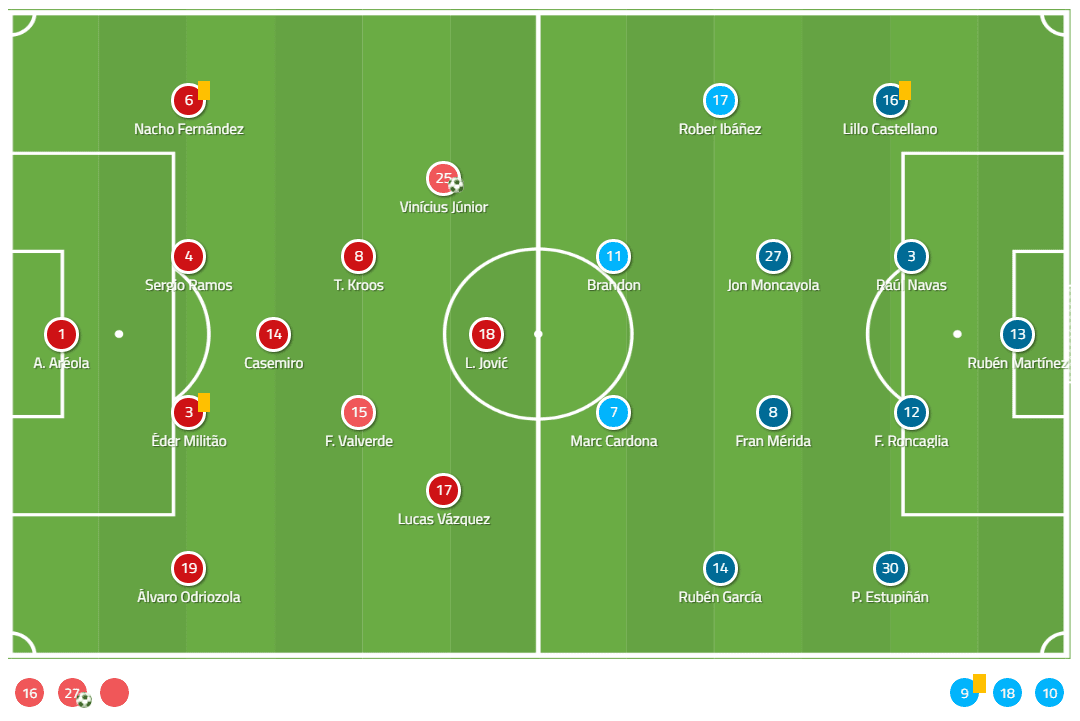
With Ferland Mendy and Marcelo out injured, Zidane was always going to make at least one change. However, they were widespread. Alphonse Areola, Álvaro Odriozola, Éder Militão, Nacho, Federico Valverde, Lucas Vázquez, Vinícius Júnior and Luka Jović all came into the team, with Gareth Bale dropped from the squad entirely as Zidane kept one eye on the Madrid derby at the weekend.
Osasuna too made seven changes, two in attack, two in midfield and three in defence, as they looked to rotate a slim squad ahead of a much more winnable fixture against Levante at the weekend.
The new midfield three?
The most intriguing change that Zidane made was in midfield, where Valverde was deployed as an alternative to Luka Modrić. The Uruguayan took up the most advanced of the three midfield positions, even supporting Jović at times, but was not as offensive as the likes of James Rodríguez or Isco. This allowed him to be more involved in the attacking phase, where he was more involved than in all but two of his previous appearances for the club judging by the number of offensive duels and actions he was involved in, continually linking the midfield with the attack.
With 19 received passes, he was influential throughout, but also provided another key figure as he allowed Casemiro and Toni Kroos to play in their more natural game. With James in the team, they would typically be forced to be more defensive and disciplined in their positioning. Often, both would have to act as makeshift full-backs, but with Valverde in the side, this could easily be rotated to allow Kroos or Casemiro to break forward with Valverde content to sit deeper.
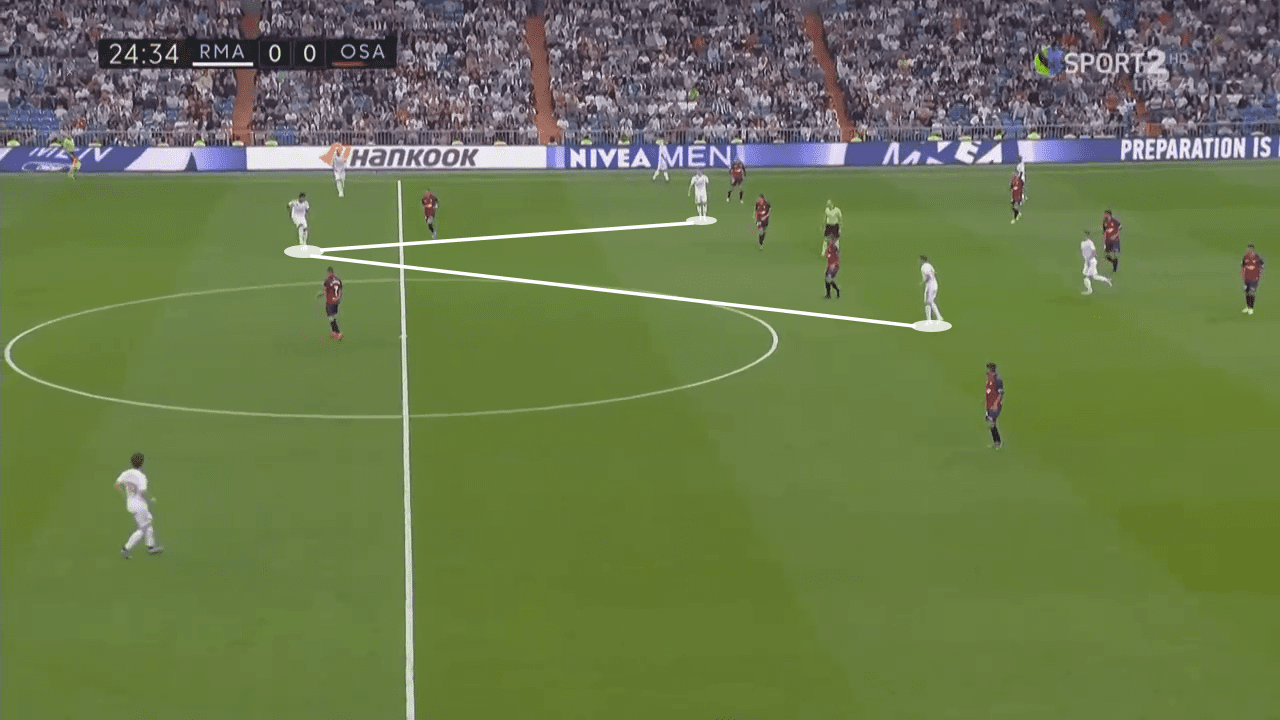
Zidane has clearly had his doubts about James and his role in the past, he has been in superb form since returning to the club in the summer. That said, Valverde continues to prove to be a valuable alternative. Should he prove that the more advanced position can be made more defensively reliable through his intelligence and positioning, the Colombian may come under serious pressure for his place in the team.
Osasuna’s counter-attacking threat
Osasuna had their own set-up, equally as well planned and organised. It should come as no surprise given their good form since their return to La Liga, but it was on the attack where they were particularly interesting at the Bernabéu. Their attacking play was built almost entirely around their approach on the counter, looking to break forwards quickly and in numbers by looking to isolate Real Madrid defenders and capitalise on the poor positioning of full-backs, despite the fact that neither Nacho nor Odriozola are as defensively lax as the alternatives who were not in the line-up.
As soon as Osasuna won possession, they would immediately look to shift the ball to Fran Merida or Jon Moncayola in central midfield to play a long ball over the top. When this happened, Marc Cardona, Brandon and later Chimy Ávila would look to take on one central defender with a pacey run, whilst the other would be occupied by a winger making a wider run. This split the central defensive pairing in a way which would give the Osasuna player an option should he win the ball and look to cut it back to a supporting run.
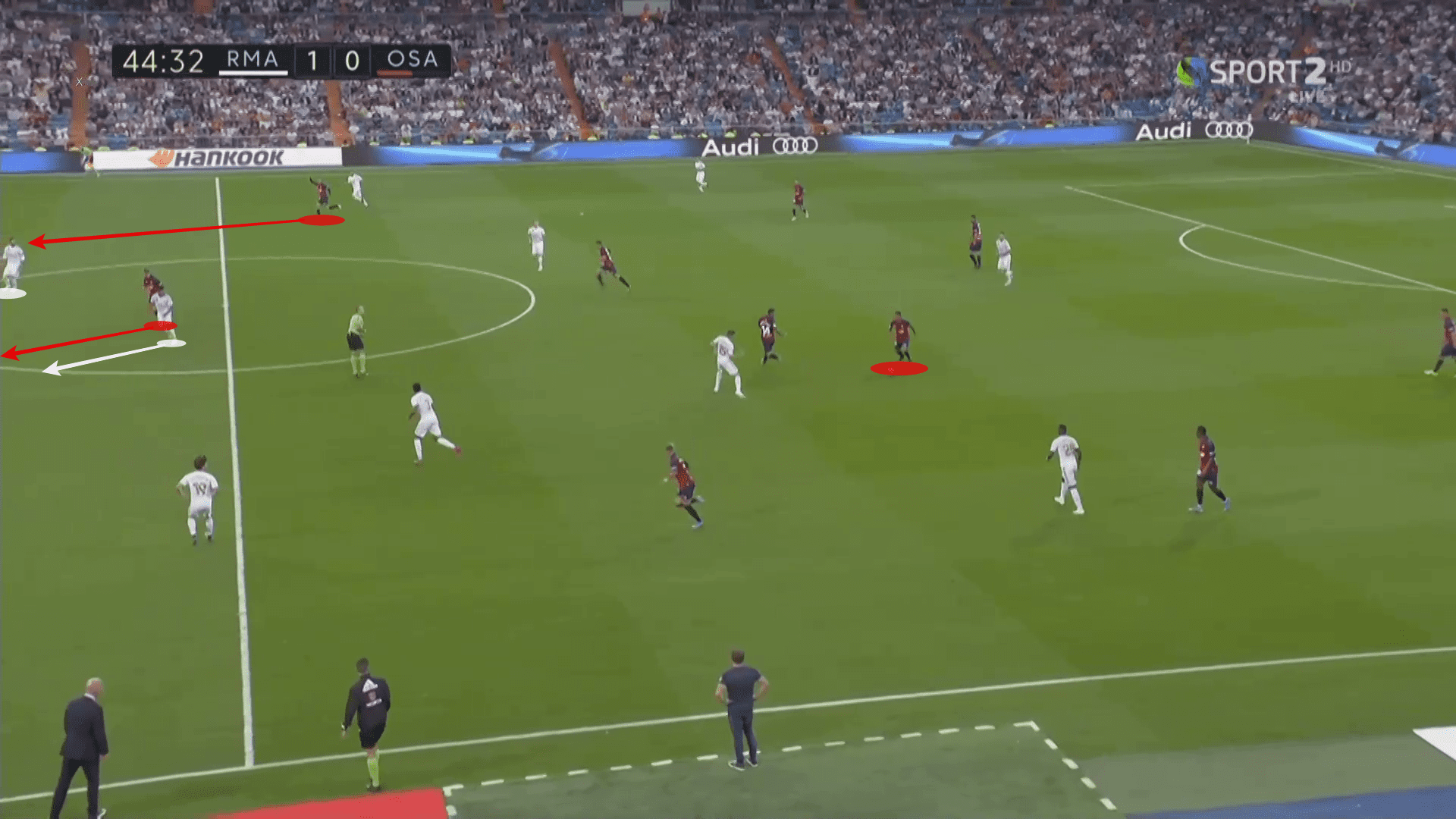
It is worth noting here though, that despite the attacking threat which Osasuna presented on the break on several occasions, at no point did they register a shot on target. For a second consecutive game, Real Madrid prevented a single shot from reaching their goal. Coming after the thrashing in Paris, no-one can accuse Zidane and his side of not stepping up their game when they needed to most.
Unbalanced width on the flanks
With Vázquez and Vinícius on the flanks, it was a clear selection of 4-3-3 from Zidane. The role was clearly intentional and had its aims. Whilst Vinícius had far more touches in the box, shrugging off more of his defensive duties, he dominated the more offensive positions with four touches inside the penalty box, compared to just one from Vázquez. Alternatively, Vázquez provided far more, with three shot assists compared to not a single one from the teenager and five crosses compared to just two.
What may concern Real Madrid fans is that despite having this more advanced role, only just behind Jović, Vinícius still failed to look clinical. His goal took a deflection to help it on its way and even then, he only recorded one other shot, worth 0.01 xG and again failed to look convincing when looking to add the finishing touch to a move. On the other hand, Vázquez recorded 0.13 xG from the same number of shots. Vinícius continues to adapt to Spain, but a goalscoring streak would certainly not harm him.
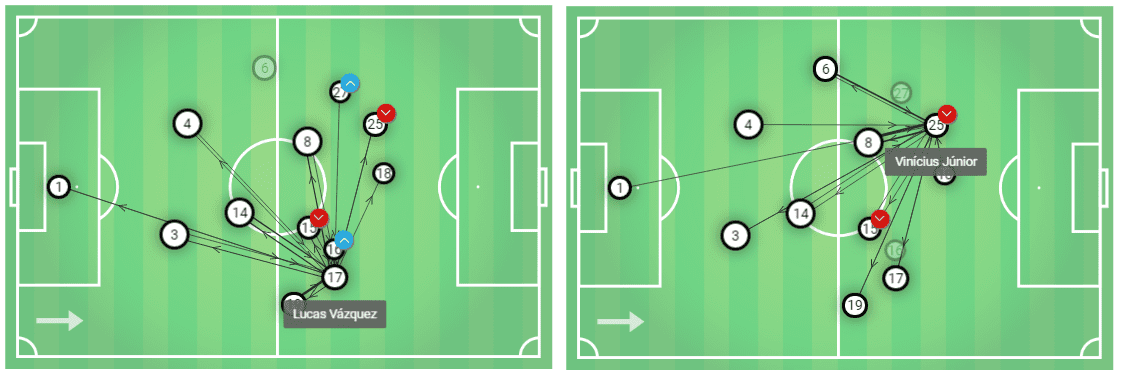
This created an unbalanced set-up, largely by design, as Vázquez sat deeper and allowed Odriozola more freedom to overlap whilst Nacho on the left flank is not as adventurous and can be trusted to allow Vinícius to run the show in the attacking phase. In total, Vázquez was involved in almost as many five times more defensive duels in this fixture. This aided the defensive set-up where Osasuna directed 50% of their movements in that direction, down the right flanks, whilst all others came through the middle channel.
Rodrygo’s impact
With that focus on wide play, it was the perfect time to provide a first team debut for summer arrival Rodrygo. He provided a very different threat, unlike that of Vázquez or Vinícius. Using the pace and skill of Vinicius, he stuck to the wide areas like Vázquez, and did so to devastating effect even after scoring a debut goal after only 93 seconds. In fact, he completed four dribbles and registered three progressive runs, almost surpassing his compatriot despite playing 50 minutes less than the starter. That footwork was essential in the build-up to his goal, cutting past three Osasuna defenders before finishing with composure in a chance which rated at just 0.09 xG.
Another area where he impressed was with his intelligence and movement. Particularly late on in the tie as Osasuna began to tire and gaps opened up in their rigid structure, Rodrygo would look to capitalise and link-up with his full-back. In the below example, he did just that, drifting centrally as Sergio Ramos gained possession to provide a straightforward option through the middle. A quick touch and turn and the Brazilian was away, with Nacho bombing down the flank with an opportunity to create a high-quality chance. With more natural offensive full-backs like Marcelo and Mendy in the squad, the potential of such moves could be frightening as he turns possession from defence to attack in seconds.
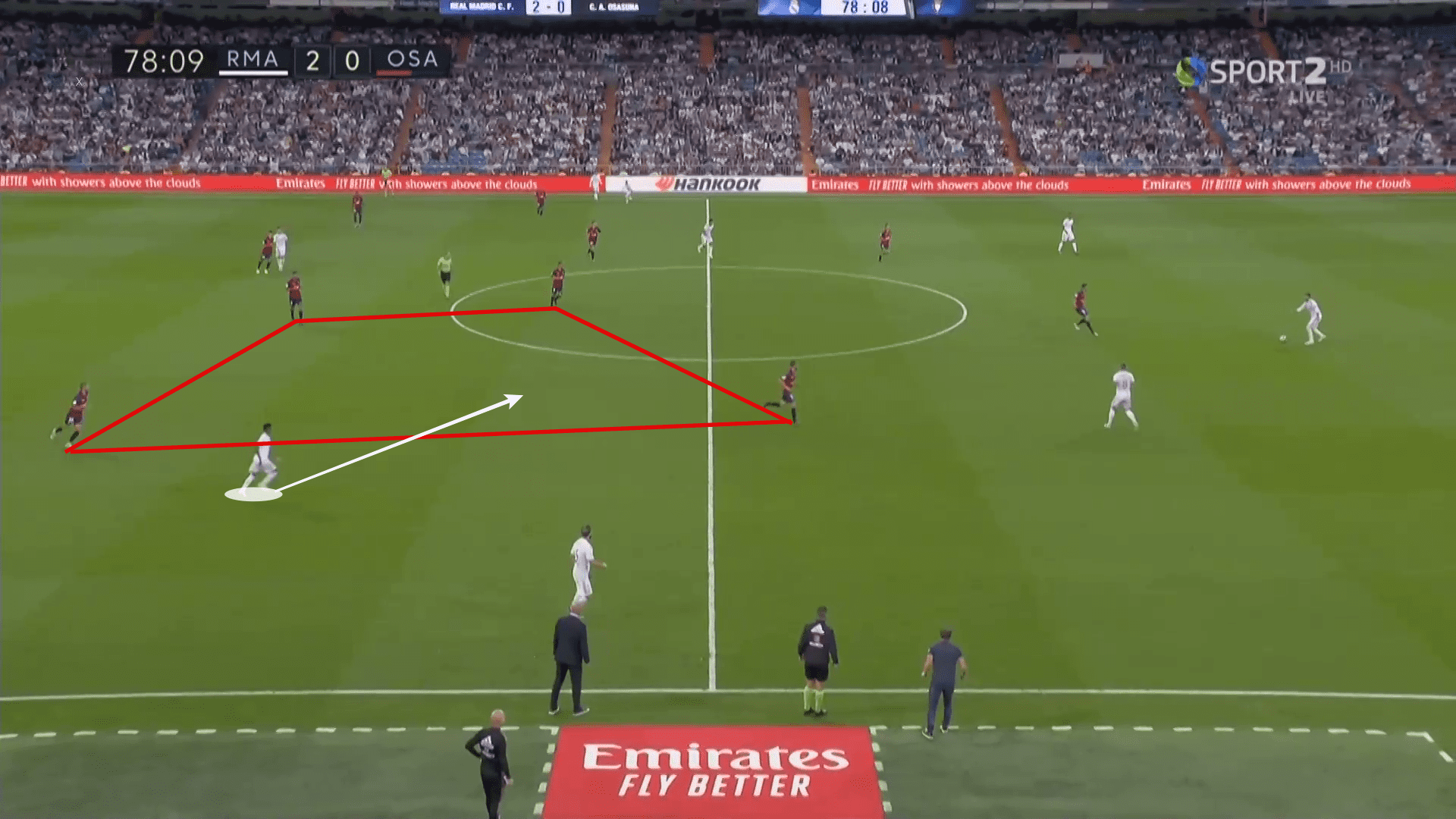
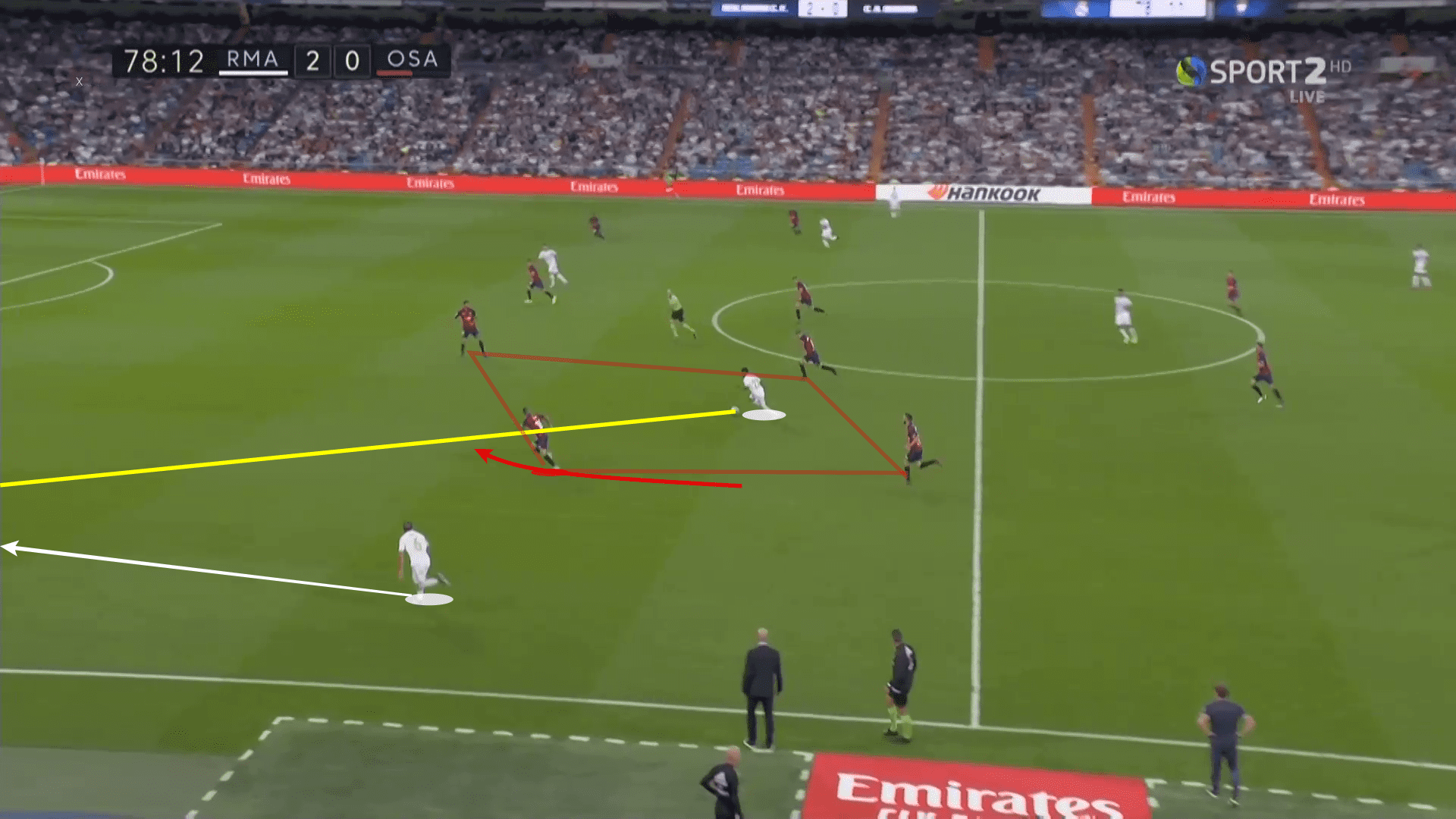
This was a promising debut for Rodrygo and one that he will certainly look to build on. His direct style and ability and desire to take on Osasuna defenders, even on his debut at such a young age, impressed and his wide positioning provides an alternative which could be one worth keeping on the bench for the first team. Like Vinícius last season, his introduction will be slow, but his early signs are ones to give Real Madrid fans real optimism.
Conclusion
This was an important victory for Zidane as it showed that he can rotate and make changes to his line-up, yet use the same system and still come out on top. When they last won La Liga in 2016/17, that was the key. Should Real Madrid go far in cup competitions, this second string will be required to face teams which will put up much more of a fight. Analysis shows that Osasuna did themselves proud, but a dominant midfield set-up and flashes of individual talent in attack decided the fixture. Real Madrid can take plenty of confidence from this victory heading into the Madrid derby against Atlético on Saturday.

If you love tactical analysis, then you’ll love the digital magazines from totalfootballanalysis.com – a guaranteed 100+ pages of pure tactical analysis covering topics from the Premier League, Serie A, La Liga, Bundesliga and many, many more. Buy your copy of the August issue for just ₤4.99 here




Comments